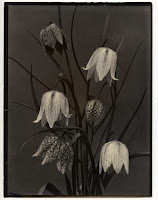








Charels Jones was a closet photographer. He was a normal guy, a family man, a very talented and passionate gardener and a little bit of a sneaky British fellow. Jones was born in England in 1866 and died at 92 in 1959. He was a wonderful gardener and managed various gardens as a job throughout his life. He documented his gardening achievements by taking these exquisite glass plate negatives of his vegetables and flowers. Jones' skill was not recognised until after his death when a box full of his (gold toned) silver gelatin prints where found randomly. All the original glass plates where destroyed as Jones used them, in his later life, to protect the young plants in his garden from the sun.
Now it is clear that Jones was a very talented man, in both his gardening and his ablity to capture life in still photographs. His images are simply composed with plain black or white backgrounds behind his subjects that are either just picked fresh from the ground or still attached to the plant. It is clear that Jones cared about his vegetables and thought about they best way to show off each of their individual features.
What i like about this work is the fact that Jones lets the subject speak for themselves. He sets them up in the simplest way and then lets the fruit, vegetables and flowers show their unique and natural beauty off to the camera. He was smart enough to realise that there was something special growing in his garden. But there is also a gritty, dirty feel to them which i like.
Textures, forms and beauty in nature.
Got to love it.









































